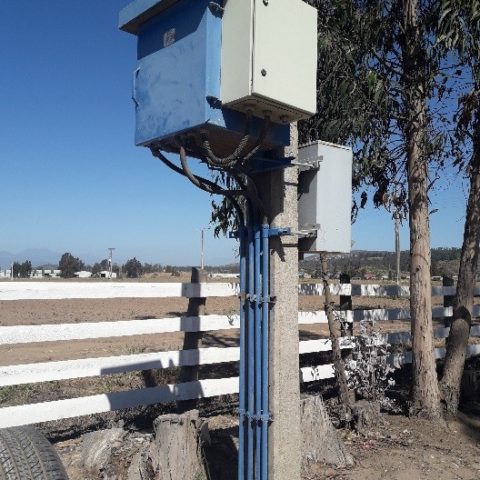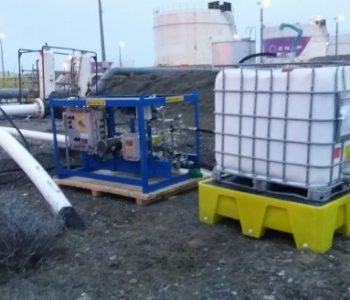[:es]
AUTOMATIZACIÓN DE UN RECTIFICADOR DE PROTECCIÓN CATÓDICA.
PRESENTACIÓN DEL CASO:
Una importante empresa de distribución de GLP ubicada en Valparaíso – Chile, detectó la necesidad de supervisar de forma remota un rectificador de su sistema de protección catódica de un gasoducto.
La traza del gasoducto contiene otros ductos paralelos y líneas férreas que generan variaciones que conllevan a dejar el sistema sin protección, acelerando el proceso de corrosión o produciendo sobreprotección provocando desprendimiento de hidrógeno con posibilidad desprendimiento o degradación del revestimiento.
-
Fecha de intervención: Marzo 2020
-
Activo: Automatización de un rectificador de protección catódica.
-
Localización: Chile
-
Tiempo: -
SOLUCIÓN
Morken Group propuso al cliente instalar un sistema de monitoreo remoto por conexión GSM/GPRS/UMTS que le permite registrar y configurar de forma continua los datos necesarios para cumplir con los criterios de protección contra la corrosión, tales como, potencial corriente continua y alterna, voltaje y corriente de trabajo del rectificador, retorno de corrientes drenadas y evaluación de potenciales On-Off.
RESULTADOS Y BENEFICIOS:
Se logró instalar sin ningún inconveniente el sistema de monitoreo remoto, permitiéndole al cliente realizar la supervisión continua del rectificador de forma remota y adecuar sus parámetros de funcionamiento a través de un computador o teléfono móvil mediante un software.
Este sistema permitió confirmar el funcionamiento correcto del sistema de protección catódica, además de permitir evaluar los criterios de protección de acuerdo a las normas internacionales.
El sistema de monitoreo también cuenta con una alarma para el registro de interrupción y restablecimiento del suministro de red eléctrica.
REPAIRS USING A COMPOSITE MATRIX FOR HIGH TEMPERATURE IN SOUTHERN ARGENTINA.
PRESENTATION OF THE CASE:
An important client that has a hydrocarbon transport network in Argentina has identified the existence of localized corrosion on a circumferential weld.
The geometry of the welded joint and the impossibility on the part of the client to be able to make a temporary stop or a reinforcement through the installation of an fitting has defined an analysis criterion to be able to present to the client a permanent solution for this case.
Next, the identified corrosion defect is shown.

-
Date of intervention: November 2019
-
Activo: Use of friction reducer
-
Location: Chile
-
Time: -
SOLUTION
As can be seen in the photo, the geometry and location of the defect limit the solutions that can be applied to give permanent solution to this defect.
Based on the analysis of available technologies to guarantee a solution in an irregular geometry, in addition to having as a condition an operation at a temperature greater than 80 ° C on a regular basis, we have identified that the use of non-metallic compounds is the best alternative as Permanent solution to this service.
In this case we have installed a pre-formed and shaped compound on each side of the defect, achieving a protrusion of the diameter of the pipe to then be able to install a high compression filling in the free space between both reinforcement rings as illustrated below:
RESULTS AND BENEFITS:
The defect has been effectively repaired in less than 3 hours, which has reduced the use of resources throughout the activity.
The circumferential weld is also protected throughout its perimeter, thanks to the use of high compression putty that allows the pressure load to be transferred to the reinforcement, thus recovering the integrity of the steel in the affected area.
Breaking pressure calculations with the reinforced pipe allow the transport capacity of the pipe to be brought to its original conditions. In addition, the repair with the high temperature compound has proven to be highly efficient, quick to install and a PERMANENT solution and much more economical than an eventual shutdown in order to make a change in the pipe segment or the manufacture of a special fitting. For this geometry.
AUMENTO DE FLUJO EN UN POLIDUCTO MEDIANTE LA UTILIZACIÓN DE AGENTE REDUCTOR DE FRICCIÓN
PRESENTACIÓN DEL CASO:
En una importante empresa de petróleo de Chile existe un poliducto que transporta kerosene de aviación, diésel B1 (Vehicular) y MGO (Diesel Marino). Ese poliducto transporta los productos a otro complejo donde son despachados a una razón de 830 m3/d (en promedio), lo que significa un transporte de 24.900 m3 al mes aproximadamente.
En los meses de alta demanda (octubre a marzo) la venta total de los productos fluctúa entre los 25.000 m3 hasta los 30.000 m3, por lo que el poliducto no es capaz de transportar los volúmenes necesarios.
Considerando estas cuestiones, el Cliente nos solicitó alcanzar por lo menos un volumen de producto transportado de 1250 m3/d (50,6 % aumento) con un volumen óptimo de 1400 m3/d (68,7% aumento).
-
Fecha de intervención: Noviembre 2019
-
Activo: Utilización de reductor de fricción
-
Localización: Chile
-
Tiempo: -
SOLUCIÓN
Dada la situación planteada por el cliente, ingenieros especializados de Morken Group realizaron un estudio preliminar del poliducto, evaluando posibles soluciones para lograr el aumento del flujo de diésel B1 y MGO.
En base al estudio realizado, se propuso la utilización de reductores de fricción para poder alcanzar los flujos de transporte objetivo.
Como parte de la solución, se definió el siguiente alcance para el proyecto:
- Análisis hidráulico del funcionamiento del poliducto.
- Ingeniería para el suministro e instalación de los equipos de inyección.
- Provisión del agente reductor de fricción (DRA).
- Servicio de inyección del aditivo.
RESULTADOS Y BENEFICIOS:
Luego de inyectar el aditivo reductor de fricción se verificó un aumento en el flujo de producto transportado, registrándose 1446 m3/d batches de B1 y 1442 m3/d batches de MGO con 20 ppm de producto. Esto equivale a un aumento de flujo del 74% aproximadamente.
El volumen máximo de producto transportado registrado a la fecha es de 1519 m3/d.
Gracias a estos resultados, el cliente ha podido dar solución a las necesidades de transporte de refinados entre plantas.
[:]














